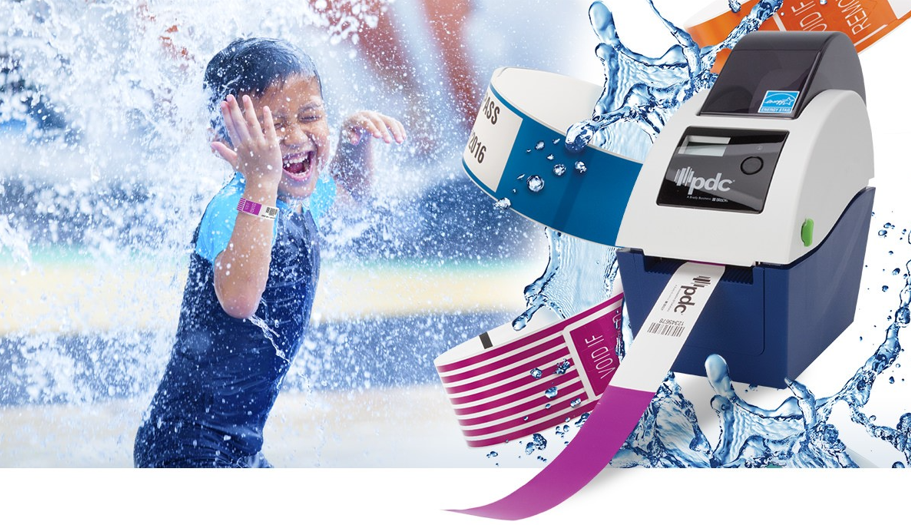How Wristbands Improve Swimming Safety and Save Lives

Editor’s Note: Drowning remains one of the leading causes of death among U.S. children. This refreshed blog shares updated guidance from public health authorities and shows how aquatic centers can use color-coded wristbands as simple, cost-effective tools to enhance supervision.
Globally, Swimming Safety Still Falls Short
“Drowning is the fourth leading cause of death for children aged 1–4 years and the third leading cause of death for children aged 5–14 years.”
This recent WHO report aligns with the CDC’s finding that through 2024, U.S. drowning deaths climbed — particularly among children under four and adults over 65. Both agencies state that swimming lessons and adult- and community-based supervision are pillars of prevention.
To support lifeguards, make color-coded admission wristbands a cornerstone of your swim safety program.
Visibility for Vigilance: Wristband Colors Classify Capabilities
Supervision becomes difficult when children outnumber designated “water watchers” at pools, water parks, theme parks, and camps.
Within designated swim classes and water safety programming:
- Water Safety USA advises that learn-to-swim programs should implement a 1:4 instructor-to-young student ratio or fewer if a caregiver isn’t in the water. A 1:6 ratio is the max.
General recreation, such as public pools or camps, changes ratios.
- The American Camp Association , for instance, recommends a 1:25 lifeguard-to-swimmer ratio or a 1:15 ratio when hosting groups that include swimmers with sensory needs or disabilities.
In high-volume settings, high-visibility swimming wristbands provide at-a-glance swimmer classification to instructors, lifeguards, and poolside parents.
- Water-resistant synthetic paper wristbands, like SecurBand®, are designed for one-day use and volume-priced for busy aquatic venues.
- Waterproof plastic or vinyl wristbands are durable, non-transferable, and bright for underwater visibility. These wristbands for swimming easily endure a week at a resort or an extended summer camp stay.

Below, we expand on the three ways wristband color coding can help shore up your swimmer safety program.
1. High-Visibility Wristbands Help Protect Swimmers
Bright, color-coded wristbands clearly designate swimmers who need additional supervision. Consider this basic wristband-based swimmer classification that many Wristbands.com customers use:
- Red = STOP! A red waterproof wristband identifies young children or swim students. In addition to monitoring, red can limit swimmers to shallow pools or identify those restricted from diving boards and intense water attractions.
- Yellow = Caution. An intermediate swimmer may access select attractions, e.g., lazy river, where vibrant, waterproof wristbands would assist in monitoring.
- Green = GO! Lime green indicates full pool and attractions access based on factors such as age, capability, and/or swim test records.
- Note: Dark shades are difficult to spot quickly under certain light conditions.
Worried swimmers may swap bands? SecurBand® is non-transferable. These value-rich wristbands feature a water-resistant adhesive closure, tamper-evident cuts, and the PDC-exclusive CleanTab™ that prevents pool filter litter.
2. Peace of Mind for Staff, Swimmers, and Guardians
Color-coded admission wristbands help lifeguards while also reassuring parents and guardians that they are following safe swim protocols. And there’s more that wristbands can do.
Swim safety wristband programs are expanding as facilities and lifeguard training programs prioritize inclusivity and accessibility. A guest can request a day glow pink wristband, for instance, if they have sensory or physical restrictions or would like assistance with pool ingress and egress.
- Panama City, FL’s Shipwreck Island Waterpark offers purple wristbands to children on the autism spectrum upon parental request. The water park wristbands help make all guests feel seen and included while freeing staff to focus on worry-free workflows that lead to safer and more enjoyable experiences.
3. Colors Can Help Create Community Goodwill
Safety is top of mind. Advertising likely isn’t.
Customizing waterproof wristbands with your logo reinforces a safety-first focus and welcoming atmosphere.
Similarly, custom pool wristbands can spread the word. Many children often wear customized vinyl or plastic wristbands long after Labor Day. Seemingly “just advertising” at first blush, customized swimming wristbands can prompt crucial conversations about swim safety.
- Synthetic paper wristbands enable any pool or park, regardless of size, to implement customized, color-coded wristbands. Wristbands.com, for instance, offers economical wristbands and thermal printer bundles, allowing staff to print wristbands instantly with logos and student information.
Color-Coded Wristbands Strengthen Swim Safety Strategies
Consider color-coded wristbands as an added safety element — even the most eagle-eyed lifeguard can’t see behind every splash. Helping staff and guardians respond faster starts with contacting Wristbands.com today. Our leisure and entertainment specialists will guide you through waterproof wristband options to strengthen your swim safety program.

 FREE GROUND SHIPPING OVER $99
FREE GROUND SHIPPING OVER $99
 SAFE AND SECURE
SAFE AND SECURE





